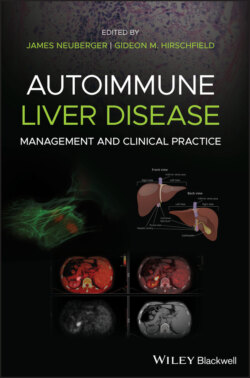Читать книгу Autoimmune Liver Disease - Группа авторов - Страница 46
Liver as an Innate Immune Organ
ОглавлениеThe liver is an essential innate immune organ that must either tolerate or respond to microbial PAMPs, toxins, xenobiotics, food antigens, microbial pathogens, and neoplastic cells [6]. The liver contains specialized liver sinusoidal endothelial cells (LSECs) and large quantities of Kupffer cells, DCs and NK, NKT and γδT cells. Most intrahepatic B cells are B1 cells, an innate B‐cell subset that secretes low‐affinity IgM antibodies against glycoproteins, called “natural antibodies.”
The liver also synthesizes C′ proteins, acute‐phase reactant proteins, and multiple cytokines. PAMP and DAMP activation of TLRs on Kupffer cells, LSECs, hepatocytes, DCs and HSCs primarily generates IL‐10, providing an immunosuppressive environment. However, high quantities of PAMPs or DAMPs induce the proinflammatory cytokines IL‐1β, IL‐6, IL‐12, IL‐18 and TNF‐α. HSCs normally produce matrix proteins, but once transformed into myofibroblasts they secrete collagen, resulting in fibrosis. PAMPs and DAMPs also induce NLRP3 inflammasome responses [5] in hepatocytes, cholangiocytes and HSCs, resulting in their secretion of proinflammatory cytokines and chemokines.
The reticuloendothelial function of the liver normally prevents PAMPs, DAMPs and microbial antigens in portal venous blood from entering the systemic circulation. This barrier function of the liver also plays a role in oral tolerance. Hepatic lymph formed in the space of Disse flows retrograde into portal tract lymphatics. Thus, hepatic lymph exposes portal bile ducts, arterioles and portal vein branches to variable amounts of PAMPs, DAMPs, cytokines, chemokines, proteins, lipoproteins, and lipids.
